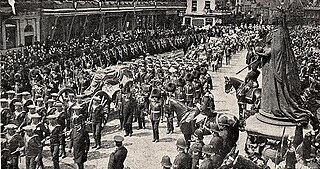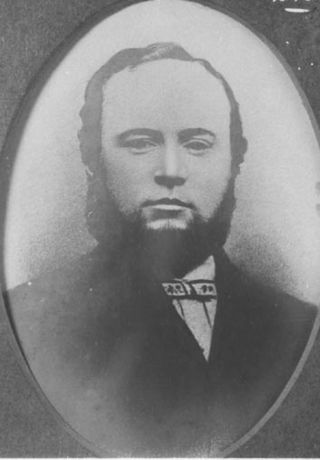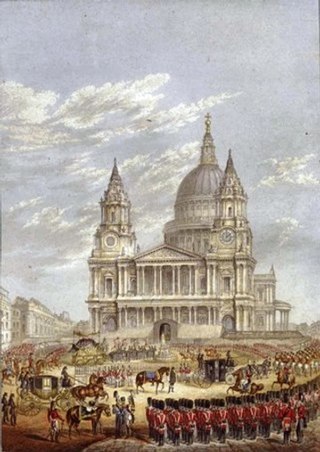
The Worshipful Company of Upholders is one of the Livery Companies of the City of London. "Upholder" is an archaic word for "upholsterer". In past times, upholders did not just manufacture and sell upholstered goods but were cabinet makers, undertakers, soft furnishers, auctioneers, and valuers. The organisation was formed on 1 March 1360 and officially incorporated by a Royal Charter granted by Charles I in 1626. The Company originally had the right to set standards for upholstery within London and to search, seize and destroy defective upholstery. However, over the years, the Company's power has eroded, as has the profession of upholsterers, because of the advancement of technology.

William Banting was a notable English undertaker. Formerly obese, he is also known for being the first to popularise a weight loss diet based on limiting the intake of carbohydrates, especially those of a starchy or sugary nature. He undertook his dietary changes at the suggestion of Soho Square physician William Harvey, who in turn had learned of this type of diet, but in the context of diabetes management, from attending lectures in Paris by Claude Bernard.

William Vile was an English cabinetmaker.
John Cobb was an English cabinetmaker and upholsterer.

Ince and Mayhew were a partnership of furniture designers, upholsterers and cabinetmakers, founded and run by William Ince (1737–1804) and John Mayhew (1736–1811) in London, from 1759 to 1803; Mayhew continued alone in business until 1809. Their premises were located in Marshall Street but were listed in London directories in Broad Street, Soho, 1763–83, and in Marshall Street, Carnaby Market, 1783–1809. The partnership's volume of engraved designs, The Universal System of Household Furniture, dedicated to the Duke of Marlborough, was issued in imitative rivalry with Thomas Chippendale; Ince, who was a subscriber to the first edition of Chippendale's Director, was chiefly responsible for the designs, while Mayhew contributed the greater part of the partnership's capital, kept the accounts, and was in closer contact with the firm's clientele among the nobility and gentry. The name of the firm originally appears to have been "Mayhew and Ince", but on the title page of The Universal System the names are reversed, suggesting that Ince was the more extensive contributor.

George Bullock (c.1777–1818) was a sculptor and furniture-maker working in Liverpool and London.

Edward VII, King of the United Kingdom of Great Britain and Ireland and Emperor of India, died on Friday 6 May 1910 at the age of 68. His state funeral occurred two weeks later, on 20 May 1910. He was succeeded by his only living son, George V.
John (Jean)Pelletier (fl. ca 1681 – 1704) was a French Huguenot carver and gilder, who emigrated from Paris, where he had trained, and worked in London. He provided high-style Baroque furniture for the court of William III and Mary II, specializing in carved, gessoed and gilded furniture of the highest quality. He was also employed in providing carved and gilded picture and looking-glass frames and in gilding the work of other carvers.
Benjamin Goodison of London, was a royal cabinetmaker to George II of Great Britain, supplying furnishings to the royal palaces from 1727 to the time of his death. He served his apprenticeship with James Moore, who died accidentally in October 1726; Moore was the pre-eminent London cabinetmaker during the reign of George I. Goodison's classicizing case furniture owes much of its inspiration to the neo-Palladian designs of William Kent; outstanding documented examples are the pair of part-gilded mahogany commodes and library writing-tables Goodison made for Sir Thomas Robinson of Rokeby Hall, Yorkshire, now in the Royal Collection; they have boldly-scaled Greek key fret in their friezes and lion masks gripping brass rings heading scrolling consoles at their corners.

Francis Murray (1838–1872) was an alderman and mayor of the Brisbane Municipal Council.

In the United Kingdom, state funerals are usually reserved for monarchs. The most recent was the state funeral of Queen Elizabeth II on 19 September 2022.
William France Sr. was born in the small agricultural village of Whittington, six miles north of Lancaster, where he was christened on 7 January 1727 the second son of Edward, a yeoman farmer, and Agnes France. His elder brother, John, was christened on 27 March 1725 and was apprenticed to a cabinetmaker in Lancaster where he married Elizabeth Townson the daughter of John Townson, a joiner, in 1747.
Edward France was a cabinetmaker and upholsterer in 18th century London and a member of the well known France family who held the Royal Warrant for over half a century. He was the nephew of William France Snr and older brother of William France Jr, both of whom were cabinetmakers to the Royal Household. He was born in 1748 and died in 1777. He was made a Freeman of Lancaster in 1773–74.
Collier and Plucknett were a Warwick, England based Victorian-era furniture maker, best known for their Gothic revival pieces.

The funeral directors to the Royal Household of the Sovereign of the United Kingdom are selected and appointed by the Lord Chamberlain's Office.

Victoria, Queen of the United Kingdom of Great Britain and Ireland and Empress of India, died on 22 January 1901 at Osborne House on the Isle of Wight, at the age of 81. At the time of her death, she was the longest-reigning monarch in British history. Her state funeral took place on 2 February 1901, being one of the largest gatherings of European royalty.
William Trotter of Ballindean JP DL (1772–1833) was a Scottish cabinet-maker who served as Lord Provost of Edinburgh from 1825 to 1827.

On 6 February 1952, George VI, King of the United Kingdom, died at the age of 56, at Sandringham House, after a prolonged cancer. His state funeral took place on 15 February 1952. A period of national mourning commenced and his eldest daughter and successor, Queen Elizabeth II, was proclaimed the new monarch by the Accession Council. George VI's coffin lay in St Mary Magdalene Church, Sandringham until 11 February when it was carried, in procession, to the nearby Wolferton railway station. The coffin was carried by train to London King's Cross railway station where another formal procession carried it to Westminster Hall where the king lay in state for three days. Some 304,000 people passed through Westminster Hall with queues up to 4 miles (6.4 km) forming.

Arthur Wellesley, 1st Duke of Wellington, died on 14 September 1852, aged 83. He was the commander of British forces and their allies in the Peninsular War and at the Battle of Waterloo, which finally ended the Napoleonic Wars, and served twice as Prime Minister of the United Kingdom. Although Wellington's political career had led to his unpopularity because of his opposition to the Great Reform Act, in old age it was his military career which was remembered and he was revered as a national hero. His state funeral on 18 November at St Paul's Cathedral in London was the grandest of any in Britain during the 19th century.

Vice-Admiral Horatio Nelson, 1st Viscount Nelson, was given a state funeral in London on 9 January 1806. It was the first to be held at St Paul's Cathedral and was the grandest of any non-royal person to that date. Nelson was shot and killed on 21 October 1805, aged 47, aboard his flagship, HMS Victory, during the Battle of Trafalgar, part of the Napoleonic Wars. The successful outcome of the battle against a larger Franco-Spanish fleet, secured British naval supremacy and ended the threat of a French invasion of the United Kingdom. Nelson's previous victories meant that he was revered as a national hero and news of his death was met with near universal shock and mourning. The scale of his funeral was not only an expression of public sentiment, but also an attempt by the British Government to improve the perception of its prosecution of the war.












